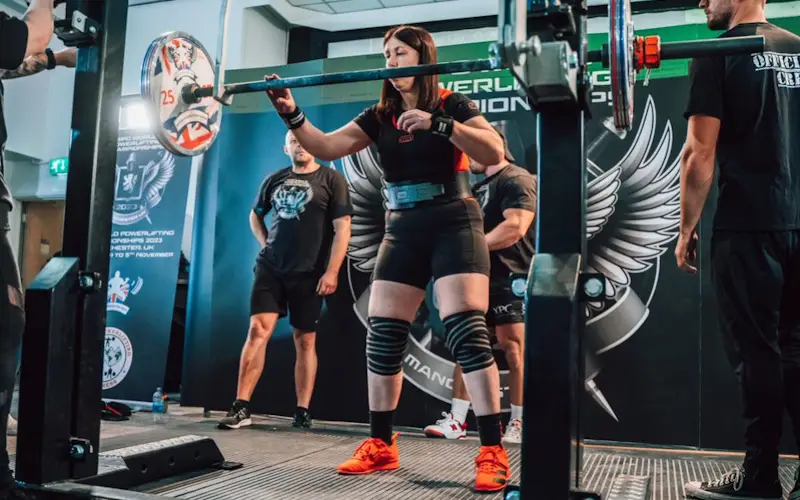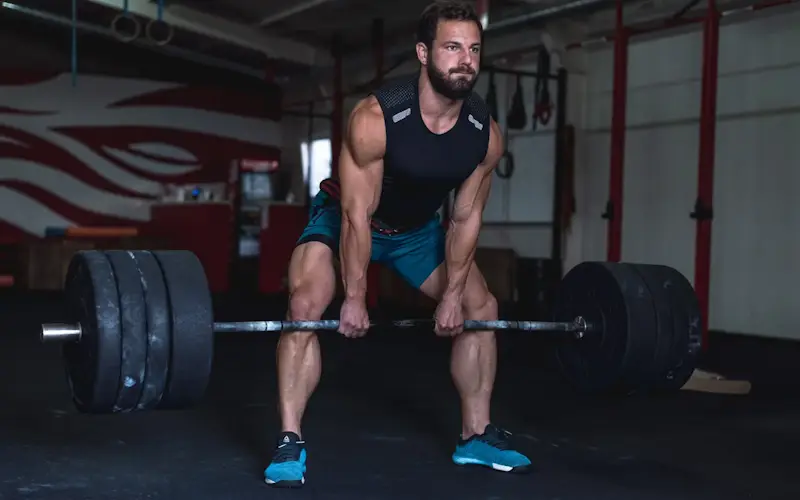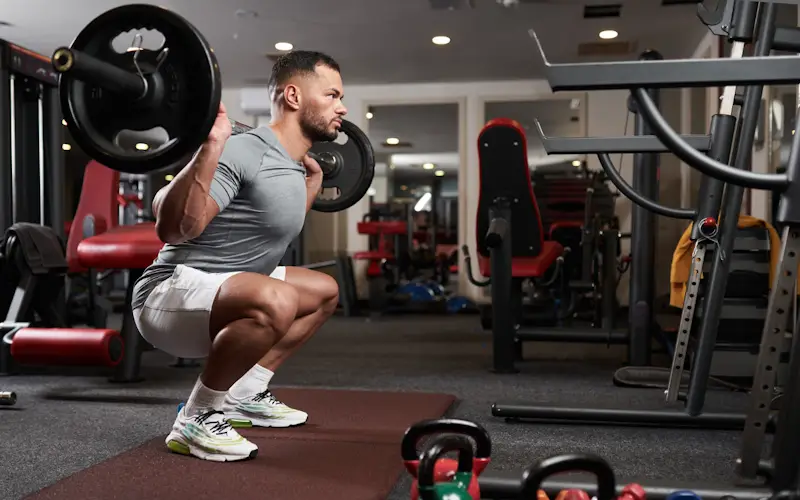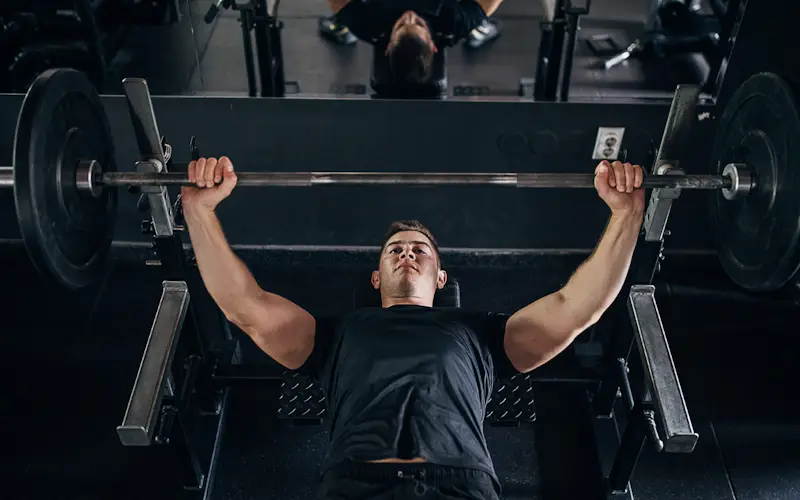What physical advantages can powerlifting offer?
“Powerlifting offers physical benefits like increased strength, muscle mass, bone density, and metabolism. It enhances overall functional fitness and promotes fat loss. Regular powerlifting can also improve posture, balance, and joint stability, reducing the risk of injuries.”
Key Highlights
- Powerlifting is a strength sport that involves lifting heavy weights and has numerous physical and mental benefits.
- It focuses on three main lifts: squat, bench press, and deadlift, which work muscles throughout the body.
- Powerlifting differs from bodybuilding and weightlifting in terms of the goals and focus of training.
- Debunking common myths: it is suitable for everyone, not just men, and it is not necessarily dangerous or only for advanced lifters.
- Powerlifting offers physical advantages such as increased strength, enhanced bone density, improved body composition, and psychological benefits like boosted mental health and self-confidence.
- It can nurture discipline and patience and requires proper techniques and safety measures to prevent injuries.
- FAQs about powerlifting: Can it help in weight loss? Is it suitable for all ages?
Introduction
If you’re looking for a great way to get fit and healthy, powerlifting might be the sport for you. It is a strength sport that involves lifting heavy weights to test your maximum strength in three main lifts: squat, bench press, and deadlift. This sport offers numerous physical and mental benefits, and it’s not just for professional athletes or bodybuilders. In this blog, we will explore the benefits of powerlifting, including using barbell lifts and how it can improve your overall well-being.
Powerlifting is not just about lifting heavy weights; it’s about developing functional strength and performance. Unlike other forms of strength training, such as bodybuilding or weightlifting, powerlifting focuses on lifting the heaviest weights possible for 1-5 repetitions rather than doing higher repetitions with lighter weights. It’s not about how your body looks but how strong it is and what it can do. It is a strength sport that requires discipline, dedication, and the proper technique to perform the lifts safely and effectively.
The following sections will examine the sport, demystifying it and debunking common myths. We will explore its physical advantages, such as building superior strength, enhancing bone density, and promoting fat loss and muscle gain. Additionally, we will discuss its psychological and emotional gains, including how it boosts mental health, improves self-esteem, and nurtures discipline and patience. We will also provide tips on techniques and safety measures for beginners and answer some frequently asked questions about the discipline.

What are the Benefits of Powerlifting?
Powerlifting is a strength sport that has gained popularity among fitness enthusiasts and athletes worldwide. It is a form of resistance training focusing on three main lifts: the squat, bench press, and deadlift. These lifts are compound movements that engage multiple muscle groups simultaneously, making the sport an effective way to build overall strength and develop functional fitness. Its emphasis on heavy weights and compound movements is a great way to target building muscle and improving strength.
Powerlifting is often referred to as a strength sport because it tests an individual’s maximum strength in the three main lifts. The goal is to lift as much weight as possible for a single repetition, known as the one-repetition maximum (1RM). Powerlifters train specifically to increase their 1RM performance in the squat, bench press, and deadlift to achieve their maximum weight capacity.
Resistance training, like powerlifting, has been shown to have numerous health benefits, including increased muscle strength and endurance, improved bone density, and enhanced metabolism. Regular training can help individuals develop functional strength, improving performance in daily activities and sports.
Whether you’re a beginner or an experienced lifter, powerlifting can be tailored to your fitness level. It offers a progressive training approach that allows you to start with lighter weights and gradually increase the load over time, promoting physical health. Additionally, it provides a sense of accomplishment as you set and achieve personal goals, increasing confidence and self-esteem. Understanding and maintaining the correct form and technique is crucial in the sport, ensuring safety and maximizing physical health benefits.
In the next sections, we will examine the basics, including the main lifts and how powerlifting differs from other forms of strength training. We will also debunk common myths and explore the physical and psychological benefits of engaging in this strength sport.
The Basics of Powerlifting: Squats, Bench Press, and Deadlifts
The three main lifts in powerlifting are the squat, bench press, and deadlift. These exercises target different muscle groups and require proper technique and form to perform effectively.
The squat is a compound movement that primarily targets the muscles of the lower body, including the quadriceps, hamstrings, and glutes. It involves bending the knees and hips to lower the body into a squatting position and then driving through the heels to return to a standing position. Squats are known for building lower body strength and developing squat-specific strength.
The bench press is a compound movement that targets the upper body’s muscles, particularly the chest, shoulders, and triceps. It involves lying flat on a bench, pushing a barbell away from the chest, and lowering it back down. The bench press is a staple exercise in the sport and is crucial for developing upper body strength and building a strong bench press.
The deadlift is a compound movement that engages multiple muscle groups, including the hamstrings, glutes, lower back, and upper back. It involves lifting a barbell from the floor while maintaining a neutral spine and lowering it back down. Deadlifts are known for their ability to develop overall strength and target the posterior chain muscles.
To excel in powerlifting, individuals must focus on proper technique and form for each lift. This includes maintaining a stable core, using the appropriate grip and stance, and executing the movements with control and precision.
In the next section, we will discuss how this discipline differs from bodybuilding and weightlifting, highlighting the unique aspects of this strength sport.
How Powerlifting Differs From Bodybuilding and Weightlifting
While powerlifting, bodybuilding, and weightlifting all involve resistance training and lifting weights, there are distinct differences in their goals and training methodologies.
Powerlifting focuses on lifting the heaviest weights possible for 1-5 repetitions, primarily testing an individual’s maximum strength in the squat, bench press, and deadlift. The emphasis is on building strength and power rather than aesthetics or athleticism. Powerlifters train specifically to increase their 1RM performance in these lifts.
On the other hand, bodybuilding is all about sculpting and defining muscles for aesthetic purposes. Bodybuilders aim to maximize muscle size, symmetry, and definition through various exercises that target specific muscle groups. The training includes higher repetitions with lighter weights to induce muscle hypertrophy and create the desired muscular appearance while reducing body fat as much as possible.
Weightlifting, also known as Olympic weightlifting, is a sport that involves lifting weights in two specific lifts: the snatch and the clean and jerk. Unlike powerlifting, which focuses on maximum strength in three lifts, weightlifting emphasizes explosive power, speed, and technique. It requires a combination of strength, flexibility, and coordination to perform these complex movements precisely. Olympic weightlifters who compete in the Summer Olympics also incorporate lifts derived from the main two lifts, such as the clean-and-jerk and the snatch, into their training.
While all three sports involve resistance training and lifting weights, powerlifting stands out as a strength sport that focuses on heavy weights and maximal strength.

Debunking Common Powerlifting Myths
Several common myths and misconceptions about powerlifting may deter individuals from trying this strength sport. Let’s debunk these myths and provide accurate information about the sport.
Myth #1: Powerlifting is Not Suitable for Women
One common myth about powerlifting is that it is not suitable for women. However, this is far from the truth. It is a sport that welcomes individuals of all genders and fitness levels. Countless women have embraced powerlifting and achieved remarkable results in strength, muscle definition, and overall fitness.
Powerlifting allows women to challenge themselves physically and mentally while developing strong muscles and improving their overall strength. It can help women build confidence, redefine societal beauty standards, and break stereotypes about women and strength training.
Myth #2: Powerlifting Necessarily Leads to Injury
Another common myth is that it is dangerous and necessarily leads to injury. While powerlifting, like any form of resistance training, carries a certain level of risk, it is no more dangerous than other physical activities when done correctly and with proper safety measures.
To prevent injuries, it is crucial to prioritize safety and follow proper technique guidelines. This includes using appropriate equipment such as knee sleeves and wrist wraps for added support, maintaining good form during the lifts, and gradually progressing in weight to avoid overexertion.
Additionally, incorporating adequate warm-up, cool-down, and stretching routines into your training can help decrease the risk of injury and improve overall flexibility. Taking the necessary precautions and training under a qualified coach or trainer’s guidance can make it a safe and rewarding sport.

The Physical Advantages of Engaging in Powerlifting
Engaging in powerlifting offers numerous physical advantages that can significantly improve your overall health and well-being. This section will discuss how the sport can help you build superior strength, enhance bone density, and promote fat loss and muscle gain.
Building Superior Strength and Endurance
Powerlifting is known for its ability to develop superior strength and endurance. By lifting heavy weights for low repetitions, powerlifters build functional strength that translates into improved performance in daily activities and sports.
The compound movements involved, such as squats, bench press, and deadlifts, engage multiple muscle groups simultaneously, resulting in a more balanced and functional physique. These compound movements also promote cardiovascular endurance, requiring large muscle groups and elevating heart rate during the training sessions.
Powerlifting can help you develop superior strength, endurance, and overall physical fitness by consistently challenging your muscles and progressively increasing the weight lifted.
Enhancing Bone Density Through Progressive Overload
One significant advantage of powerlifting is its positive impact on bone density. The repetitive loading and stress placed on the bones during heavy lifting stimulate bone remodeling and lead to increased bone mineral density.
Our bone density naturally decreases as we age, making us more susceptible to fractures and osteoporosis. Heavy lifting, particularly through progressive overload, helps counteract this age-related decline in bone density. Powerlifting promotes stronger bones by gradually increasing the weight lifted over time, reducing the risk of fractures and osteoporosis.
Incorporating lifting into your fitness routine can be especially beneficial for older adults. It helps maintain joint health, improves balance and stability, and enhances overall functional strength.
The Role of Powerlifting in Fat Loss and Muscle Gain
Powerlifting can significantly contribute to fat loss and muscle gain. While powerlifters may not have the same aesthetic appearance as bodybuilders, their training style promotes increased muscle mass and improved body composition.
Lifting heavy weights requires substantial energy, resulting in a high calorie expenditure. This calorie burn can contribute to fat loss when accompanied by a balanced diet and proper nutrition.
Furthermore, powerlifting stimulates muscle growth and hypertrophy, increasing muscle mass. Building lean muscle through this sport also helps increase your metabolic rate, as muscle tissue requires more energy than fat tissue. As a result, lifting can help you build a stronger, leaner physique while promoting fat loss and improved body composition for the average powerlifter.

Psychological and Emotional Gains from Powerlifting
Engaging in powerlifting goes beyond physical benefits; it also offers numerous psychological and emotional gains. This section will discuss how it can boost mental health and well-being, impact self-esteem and body image, and nurture discipline and patience.
How Powerlifting Boosts Mental Health and Well-being
Powerlifting has been shown to have positive effects on mental health and well-being. Regular exercise releases endorphins in the brain, known as “feel-good” hormones. These endorphins can help alleviate stress, reduce anxiety and depression, and improve overall mood.
Engaging in heavy lifting also gives individuals a sense of accomplishment and achievement. Setting and achieving personal goals, witnessing progress in strength and performance, and overcoming challenges in training can significantly boost self-esteem and self-confidence.
Powerlifting can also promote a positive body image and improve body acceptance. By focusing on strength and performance rather than appearance, lifting weights helps individuals develop a healthier relationship with their bodies and appreciate what their bodies can do rather than how they look.
The Impact of Powerlifting on Self-esteem and Body Image
Powerlifting can have a powerful impact on self-esteem and body image. By setting and achieving personal goals in strength and performance, individuals develop a sense of accomplishment and confidence in their abilities. This sport empowers individuals to focus on what their bodies can do rather than how they look, leading to improved body acceptance and self-confidence.
It also requires mental strength and discipline. Training and working towards personal goals builds resilience and determination, which can be applied to other areas of life. Powerlifting challenges individuals physically and mentally, fostering personal growth and mental fortitude.

Nurturing Discipline and Patience Through Powerlifting
Powerlifting is a sport that requires discipline and patience. This section will explore how it nurtures these qualities and discuss the journey from novice to competent and experienced lifter.
The Journey From Novice to Competent Lifter
The journey from novice lifter to competent powerlifter is a long-term commitment that requires discipline, dedication, and patience. Novice lifters start with lighter weights and gradually progress over time, focusing on proper technique and form.
Training requires consistency and adherence to a structured program. By consistently training and progressively increasing the weight lifted, novice lifters can gradually build strength, improve technique, and develop the necessary skills to become competent lifters.
Throughout the journey, discipline is crucial. Powerlifting requires following a training plan, maintaining proper form, and prioritizing rest and recovery. Developing discipline in the sport translates into discipline in other areas of life, leading to increased productivity, focus, and self-motivation.
Setting and Achieving Personal Goals in Powerlifting
Setting and achieving personal goals are integral aspects of powerlifting. Whether you’re a beginner or an experienced lifter, specific goals provide direction, motivation, and a sense of purpose in your training.
Setting realistic and attainable goals regarding strength, performance, and personal records helps individuals stay focused and committed to their training. By working towards and achieving these goals, powerlifters experience a sense of accomplishment and achievement, boosting self-confidence and self-esteem.
In addition to the physical benefits, setting and achieving personal goals contributes to personal growth and character development. It teaches individuals the value of persistence, hard work, and dedication, fostering a strong work ethic and a growth mindset.

Powerlifting Techniques and Safety Measures
Proper techniques and safety measures are crucial in the sport to ensure a safe and effective training experience. This section provides essential tips for beginners, including proper techniques, equipment, and safety practices.
Essential Tips for Beginners in Powerlifting
If you’re new to the sport, here are some essential tips to help you get started on your journey:
- Focus on proper technique: Before lifting heavy weights, prioritize learning and mastering the proper technique for each lift. This will maximise your performance and reduce the risk of injury.
- Gradually increase the weight: Start with lighter weights and gradually increase the load over time. This allows your body to adapt to the demands of the sport and minimizes the risk of overexertion or injury.
- Use appropriate equipment: Consider using equipment such as knee sleeves and wrist wraps to support and protect your joints during heavy lifting. These accessories can provide added stability and reduce the risk of strain or injury.
- Seek professional guidance: If you’re new to lifting, consider working with a qualified coach or trainer who can provide proper guidance and help you develop a safe and effective training program.
- Listen to your body: Pay attention to how your body feels during training. If you experience pain or discomfort, adjust your technique or seek professional advice to prevent further injury.
Preventing Common Injuries: Best Practices
While powerlifting is generally safe when done correctly, it is important to take precautions to prevent common injuries. Here are some best practices for injury prevention:
- Focus on proper form: Ensure you maintain proper technique and form throughout your lifts. This includes maintaining a neutral spine, engaging the appropriate muscles, and using the correct grip and stance for each exercise.
- Warm-up and cool down: Before your session, warm up your muscles and joints with dynamic stretches and light cardio. After your workout, cool down with static stretches and foam rolling to promote muscle recovery and flexibility.
- Use spotters or safety equipment: When lifting heavy weights, have a spotter nearby to assist you if needed. You can also use safety equipment such as squat racks or safety bars to catch the weight in case of a failed lift.
- Gradually increase the weight: Avoid making drastic jumps in weight. Gradually increase the load over time to allow your body to adapt and reduce the risk of overexertion or strain.
- Listen to your body: Pay attention to any signs of pain or discomfort during training. If you experience persistent pain or an injury, consult a healthcare professional for a proper diagnosis and treatment.
Conclusion
Powerlifting offers many physical and mental benefits, debunking common myths along the way. Embrace superior strength, endurance, and improved bone density through this empowering discipline. Discover the transformative effects on mental health, self-esteem, and body image. Harness discipline and patience, setting and achieving personal goals in the sport. Safely embark on your lifting journey with essential tips and injury prevention measures. Unveil the rewards of heavy lifting for all ages and its role in weight loss. Elevate your fitness journey with the holistic advantages of this sport.
